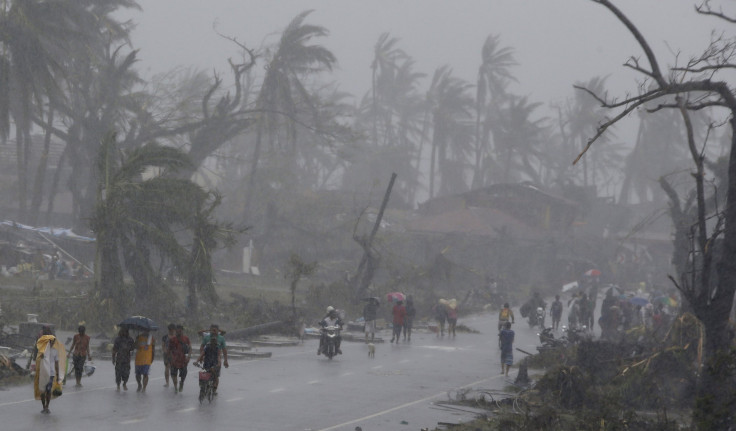Super Typhoon Neoguri Could Be First Of Tropical Storms To Slam Japan Due To El Nino

The super typhoon headed toward Japan could be the first of several intense tropical storms to slam the country this year because of El Niño, scientists say.
Typhoon Neoguri (“raccoon” in Korean) strengthened into the first “super” storm of 2014 early Monday, the Japan Meteorological Agency said, and it could batter Japan’s Okinawa archipelago and three of its mainland nuclear power plants within the next two days.
Typhoons form when thunderstorms over the Pacific Ocean pull in moisture from warm surface waters. The moisture then becomes heat in the atmosphere, which increases air flow and in turn creates the eye of a much more powerful storm.
Japan could see four to six significant storm impacts in the 2014 tropical storm season, up from just one to two major impacts last year, AccuWeather.com Senior Meteorologist Dan Kottlowski predicted.
One key reason is the high probability of an El Niño forming in the Pacific Ocean this fall and into early 2015. The World Meteorological Organization has put the odds of an El Niño at 80 percent by the end of the year, and the earliest stages of the event are already evident.
During an El Niño, the warm water that typically pools in the western Pacific near Asia and Australia is propelled eastward by shifting winds and ocean currents. The mix-up not only alters the location of the warm pool, it also increases the overall sea surface temperature of the ocean -- providing more fuel to create tropical disturbances like typhoons, Kevin Trenberth, a climate scientist at the U.S. National Center for Atmospheric Research in Colorado, said.
A 2008 study found that the number of named storms was 26 percent higher in warm El Niño years than in colder-than-average years, and that the number of storm days was 93 percent higher, according to the report by AIR Worldwide, a catastrophe risk consulting firm.
El Niño also influences where typhoons form and the trajectory they take. During normal years, when the water is warmest in the eastern Pacific, the typhoons are more likely to make landfall in mainland China, Hong Kong, the Philippines and Taiwan. But during an El Niño event, much of the activity shifts east to Hawaii and the coast of Mexico and north to Japan.
Typhoons can wreak havoc when they arrive onshore. Powerful winds knock down buildings, snap tree trunks and rip up crops as heavy floods and storm surges can inundate homes and infrastructure, multiplying the risk of drowning.
Last year’s Super Typhoon Haiyan in the Philippines, one of the strongest storms to hit land -- and which occurred during a non-El Niño year -- may have caused as much as $14.5 billion in total damage to residential, commercial and agricultural properties, AIR Worldwide said in November.
Japan has seen a big economic impact from typhoons too, and Tokyo is one of the most disaster-prone regions on earth.
"Typhoon Ewiniar hit in 2006. It caused over $1.4 billion in damages. The death toll was estimated at 141. This typhoon caused the most deaths that have hit the country as of 2013," JapaneseAnswers.com, reports.
"Typhoon Haikui ranks second for the most deaths caused by a typhoon in the country as of 2013. The death toll was estimated as 105. The typhoon caused $2.09 billion in damages. The typhoon hit in 2012. The typhoon Bart in 1999 only estimated about 16 deaths, but ranks the highest in damages with over $5 billion."
Despite the increased intensity and frequency of typhoons during El Niño years, however, the phenomenon itself “is not a bellwether when it comes to determining insured losses -- either in Japan or basin-wide,” AIR researchers wrote in the 2008 report.
Because typhoons shift toward the central and eastern Pacific, they tend not to hit large population centers or huge swathes of land as they would in normal years, Trenberth said. The risk of storm surge is also lower.
Trenberth noted during Super Typhoon Haiyan, sea levels rose by 8 inches (20 centimeters) near the Philippines. When the storm hit, a greater amount of water flooded the archipelago than would have without the temporary sea level rise.
This year, sea levels around southern Japan are actually several centimeters below normal, lowering the threat of a storm surge on par with Haiyan’s, he said.
But El Niño isn't the only climate phenomenon affecting typhoon seasons. As man-made global warming increases the Earth's temperatures, the warming of the oceans has led to more intense tropical storms in recent decades, Trenberth said, a trend that will likely continue as heat-trapping greenhouse gases increase.
© Copyright IBTimes 2024. All rights reserved.




















